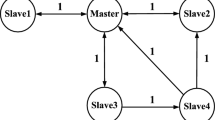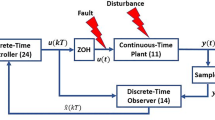Abstract
Unlike a fully-actuated manipulator, the position-posture control of a planar underactuated manipulator (PUM) is more difficult, but the research on it is significant due to the wide practical applications. The existing control methods consider no external disturbance and are involved in the staged control idea, bringing the problems of nonsmooth control torque and time-consuming. A novel one-stage control approach is proposed in this paper for the position-posture control of a three-link PUM with the first free joint under the external disturbance. By analyzing the coupling relationship between its active joints and free joint, the position-posture control is transformed into the trajectory tracking control. Unlike the general trajectory planning, the trajectories of the active joints are planned to include several parameters. Meanwhile, the parameters are solved using a chaos particle swarm optimization algorithm to guarantee that all joint angles can reach to their desired angles. Then, to obtain the high trajectory tracking accuracy at every moment under the external disturbance, the nonlinear disturbance observer is constructed and a nonlinear fast terminal sliding mode tracking controller is designed. Finally, the feasibility and superiority of this strategy are verified via two simulations.
Similar content being viewed by others
References
M. W. Spong, Underactuated Mmechanical Systems in: Control Problems in Robotics and Automation, Springer, 1998.
N. Sun, Y. Fang, H. Chen, and B. Lu, “Amplitude-saturated nonlinear output feedback antiswing control for underactuated cranes with double-pendulum cargo dynamics,” IEEE Transactions on Industrial Electronics, vol. 64, no. 3, pp. 2135–2146, 2016.
H. Lee and H. J. Kim, “Trajectory tracking control of multirotors from modelling to experiments: A survey,” International Journal of Control, Automation and Systems, vol. 15, no. 1, pp. 281–292, 2017.
K. Eliker and W. Zhang, “Finite-time adaptive integral backstepping fast terminal sliding mode control application on quadrotor UAV,” International Journal of Control Automation and Systems, vol. 18, no. 2, pp. 415–430, 2020.
Y. Liu, W. Zhan, M. Xing, Y. Wu, R. Xu, and X. Wu, “Boundary control of a rotating and length-varying flexible robotic manipulator,” IEEE Transactions on Systems, Man and Cybernetics: Systems, 2020. DOI: https://doi.org/10.1109/TSMC.2020.2999485
I. Fantoni and R. Lozano, Non-linear Control for Under-actuated Mechanical Systems, Springer, London, England, 2002.
A. Flores-Abad, O. Ma, K. Pham, and S. Ulrich, “A review of space robotics technologies for on-orbit servicing,” Progress in Aerospace Sciences, vol. 68, pp. 1–26, 2014.
A. D. Mahindrakar and R. N. Banavar, “Controllability properties of a planar 3R underactuated manipulator,” Proceedings of the 2002 International Conference on Control Applications, pp. 489–494, 2002.
S. Ahmed, H. Wang, M. S. Aslam, I. Ghous, and I. Qaisar, “Robust adaptive control of robotic manipulator with input time-varying delay,” International Journal of Control, Automation and Systems, vol. 17, no. 9, pp. 2193–2202, 2019.
Z. Huang, X. Lai, P. Zhang, Y. Wang, and M. Wu, “Virtual model reduction-based control strategy of planar three-link underactuated manipulator with middle passive joint,” International Journal of Control, Automation and Systems, vol. 19, no. 1, pp. 29–39, 2021.
J. Wu, W. Ye, Y. Wang, and C. Y. Su, “A general position control method for planar underactuated manipulators with second-order nonholonomic constraints,” IEEE Transactions on Cybernetics, 2019. DOI: https://doi.org/10.1109/TCYB.2019.2951861
A. De Luca, R. Mattone, and G. Oriolo, “Stabilization of an underactuated planar 2R manipulator,” International Journal of Robust and Nonlinear Control: IFAC-Affiliated Journal, vol. 10, no. 4, pp. 181–198, 2000.
J. Wu, Y. Wang, W. Ye, and C. Y. Su, “Control strategy based on Fourier transformation and intelligent optimization for planar Pendubot,” Information Sciences, vol. 491, pp. 279–288, 2019.
J. Wu, J. H. She, Y. Wang, and C. Y. Su, “Position and posture control of planar four-link underactuated manipulator based on neural network model,” IEEE Transactions on Industrial Electronics, vol. 67, no. 6, pp. 4721–4728, 2019.
P. Xiong, X. Lai, and M. Wu, “Position and posture control for a class of second-order nonholonomic underactuated mechanical system,” IMA Journal of Mathematical Control and Information, vol. 35, no. 2, pp. 523–533, 2018.
X. Lai, P. Zhang, Y. Wang, and M. Wu, “Position-posture control of a planar four-link underactuated manipulator based on genetic algorithm,” IEEE Transactions on Industrial Electronics, vol. 64, no. 6, pp. 4781–4791, 2017.
Y. Wang, X. Lai, P. Zhang, C. Y. Su, and M. Wu, “A new control method for planar four-link underactuated manipulator based on intelligence optimization,” Nonlinear Dynamics, vol. 96, no. 1, pp. 573–583, 2019.
P. Zhang, X. Lai, Y. Wang, and M. Wu, “Effective position-posture control strategy based on switching control for planar three-link underactuated mechanical system,” International Journal of Systems Science, vol. 48, no. 10, pp. 2202–2211, 2017.
P. Zhang, X. Lai, Y. Wang, C. Y. Su, W. Ye, and M. Wu, “A novel position-posture control method using intelligent optimization for planar underactuated mechanical systems,” Mechanism and Machine Theory, vol. 140, pp. 258–273, 2019.
G. Oriolo and Y. Nakamur, “Control of mechanical systems with second-order nonholonomic constraints: Under-actuated manipulators,” Proceedings of 30th IEEE Conference on Decision and Control, Brighton, England, pp. 2398–2403, 1991.
B. Alatas, E. Akin, and A. B. Ozer, “Chaos embedded particle swarm optimization algorithms,” Chaos, Solitons & Fractals, vol. 40, no. 4, pp. 1715–1734, 2009.
S. Shao, M. Chen, and Y. Zhang, “Adaptive discrete-time flight control using disturbance observer and neural networks,” IEEE Transactions on Neural Networks and Learning Systems, vol. 30, no. 12, pp. 3708–3121, 2019.
Y. Liu, Y. Fu, W. He, and Q. Hui, “Modeling and observer-based vibration control of a flexible spacecraft with external disturbances,” IEEE Transactions on Industrial Electronics, vol. 66, no. 11, pp. 8648–8658, 2019.
J. Huang, M. Zhang, S. Ri, C. Xiong, Z. Li, and Y. Kang, “High-order disturbance observer based sliding mode control for mobile wheeled inverted pendulum systems,” IEEE Transactions on Industrial Electronics, vol. 67, no. 3, pp. 2030–2041, 2020.
W. H. Chen, “Disturbance observer based control for nonlinear systems,” IEEE/ASME Transactions on Mechatronics, vol. 9, no. 4, pp. 706–710, 2004.
X. Fang, A. Wu, Y. Shang, and N. Dong, “A novel sliding mode controller for small-scale unmanned helicopters with mismatched disturbance,” Nonlinear Dynamics, vol. 83, no. 1–2, pp. 1053–1068, 2016.
L. Yang and J. Y. Yang, “Nonsingular fast terminal sliding-mode control for nonlinear dynamical systems,” International Journal of Robust and Nonlinear Control, vol. 21, no. 16, pp. 1865–1879, 2011.
H. K. Khalil and W. G. Jessy, Nonlinear Systems, vol. 3, Prentice hall, Upper Saddle River, NJ, 2002.
Author information
Authors and Affiliations
Corresponding author
Ethics declarations
The authors declare that they have no conflict of interest.
Additional information
Publisher’s Note Springer Nature remains neutral with regard to jurisdictional claims in published maps and institutional affiliations.
This work is supported by the National Natural Science Foundation of China under Grant 61773353, the Hubei Provincial Natural Science Foundation of China under Grant 2015CFA010, the 111 project under Grant B17040, the Fundamental Research Funds for National Universities, China University of Geosciences (Wuhan), and the Program of China Scholarship Council under Grant 201806410027.
Pan Zhang received her B.S. and Ph.D. degrees in engineering from China University of Geosciences, Wuhan, China, in 2015 and 2020, respectively. From 2017 to 2020, she was a Research Intern with the Department of Mechanical, Industrial and Aerospace Engineering, Concordia University, Montreal, QC, Canada. She is currently an Associate Professor in the School of Automation, China University of Geosciences,Wuhan, China. Her current research interests include nonlinear system control and intelligent control.
Xuzhi Lai received her B.S., M.S., and Ph.D. degrees in engineering from Central South University, Changsha, China, in 1988, 1991, and 2001, respectively. From 1991 to 2014, she was a Faculty Member of the School of Information Science and Engineering, Central South University, as a Full Professor in 2004. From 1998 to 1999, she was a Visiting Scholar with the Department of Mechatronics, School of Engineering, Tokyo University of Technology, Tokyo, Japan. From 2004 to 2006, she was a Visiting Scholar with the Department of Mechanical and Engineering, University of Toronto, Toronto, ON, Canada, and with the School of Engineering, University of Guelph, Guelph, ON, Canada. In 2014, she moved to the China University of Geosciences, Wuhan, China, where she is currently a Professor with the School of Automation. Her current research interests include intelligent control, robot control, and nonlinear system control.
Yawu Wang received his B.S. and M.S. degrees in engineering from Hubei University of Technology,Wuhan, China, in 2012 and 2015, respectively. He received his Ph.D. degree in engineering from China University of Geosciences, Wuhan, China, in 2018. He is currently an Associate Professor in the School of Automation, China University of Geosciences, Wuhan, China. His main research interests are robot control and intelligent control.
Min Wu received his B.S. and M.S. degrees in engineering from Central South University, Changsha, China, in 1983 and 1986, respectively, and a Ph.D. degree in engineering from the Tokyo Institute of Technology, Tokyo, Japan, in 1999. He was a Faculty Member at the School of Information Science and Engineering, Central South University, from 1986 to 2014, and became a Professor in 1994. In 2014, he joined the China University of Geosciences, Wuhan, China, where he is currently a Professor at the School of Automation. He was a Visiting Scholar with the Department of Electrical Engineering, Tohoku University, Sendai, Japan, from 1989 to 1990, and a Visiting Research Scholar with the Department of Control and Systems Engineering, Tokyo Institute of Technology, from 1996 to 1999. He was a Visiting Professor at the School of Mechanical, Materials, Manufacturing Engineering and Management, University of Nottingham, Nottingham, U.K., from 2001 to 2002. His current research interests include process control, robust control, and intelligent systems. Dr. Wu is a member of IEEE and a member of the Chinese Association of Automation. He was a corecipient of the International Federation of Automatic Control Control Engineering Practice Prize Paper Award in 1999 (together with M. Nakano and J. She).
Rights and permissions
About this article
Cite this article
Zhang, P., Lai, X., Wang, Y. et al. Chaos-PSO-based Motion Planning and Accurate Tracking for Position-posture Control of a Planar Underactuated Manipulator with Disturbance. Int. J. Control Autom. Syst. 19, 3511–3521 (2021). https://doi.org/10.1007/s12555-020-0553-z
Received:
Revised:
Accepted:
Published:
Issue Date:
DOI: https://doi.org/10.1007/s12555-020-0553-z




